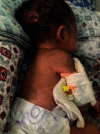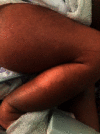A Rare Case of Staphylococcal Toxic Shock Syndrome in a Neonate
- PMID: 35686114
- PMCID: PMC9173913
- DOI: 10.1155/2022/8111620
A Rare Case of Staphylococcal Toxic Shock Syndrome in a Neonate
Abstract
Staphylococcus toxic shock syndrome (TSS) is not well described in neonates. The present criteria for diagnosis of TSS have not yet been validated in neonates. Here, we present a case of a 13-day-old female baby who presented with acute kidney injury (AKI). She had a pus-draining lesion on the head, and the pus grew Staphylococcus aureus. Based on the clinical criteria of fever, desquamation, hypotension, and AKI and laboratory criteria of absence of growth of any organisms in blood and cerebrospinal fluid, we diagnosed the case as TSS. She was treated with antibiotics, oxygen, and fluids, along with inotropic support and mechanical ventilation, and she recovered fully and was discharged on day 17 of admission. As there is no single test to diagnose TSS and it is uncommon in neonates, physicians should be familiar with the clinical presentation of the disease to make early diagnosis.
Copyright © 2022 Nipun Shrestha et al.
Conflict of interest statement
The authors declare that they no conflicts of interest.
Figures
Similar articles
-
Toxic shock syndrome with a cytokine storm caused by Staphylococcus simulans: a case report.BMC Infect Dis. 2021 Jan 6;21(1):19. doi: 10.1186/s12879-020-05731-y. BMC Infect Dis. 2021. PMID: 33407229 Free PMC article.
-
Toxic Shock Syndrome Toxin 1 Evaluation and Antibiotic Impact in a Transgenic Model of Staphylococcal Soft Tissue Infection.mSphere. 2019 Oct 9;4(5):e00665-19. doi: 10.1128/mSphere.00665-19. mSphere. 2019. PMID: 31597722 Free PMC article.
-
[Lethal, non-menstrual toxic shock syndrome associated with Staphylococcus aureus sepsis].Anaesthesist. 1995 Dec;44(12):869-74. doi: 10.1007/s001010050224. Anaesthesist. 1995. PMID: 8594962 German.
-
The Evaluation and Management of Toxic Shock Syndrome in the Emergency Department: A Review of the Literature.J Emerg Med. 2018 Jun;54(6):807-814. doi: 10.1016/j.jemermed.2017.12.048. Epub 2018 Jan 20. J Emerg Med. 2018. PMID: 29366615 Review.
-
Toxic shock syndrome of a probable gynecologic source in an adolescent: a case report and review of the literature.J Pediatr Adolesc Gynecol. 2012 Dec;25(6):e133-7. doi: 10.1016/j.jpag.2012.08.011. Epub 2012 Oct 23. J Pediatr Adolesc Gynecol. 2012. PMID: 23095525 Review.
References
-
- Centers for Disease Control (CDC) Toxic-shock syndrome, United States, 1970–1982. MMWR Morbidity and Mortality Weekly Report . 1982;31(16):201–204. - PubMed
Publication types
LinkOut - more resources
Full Text Sources
Research Materials




